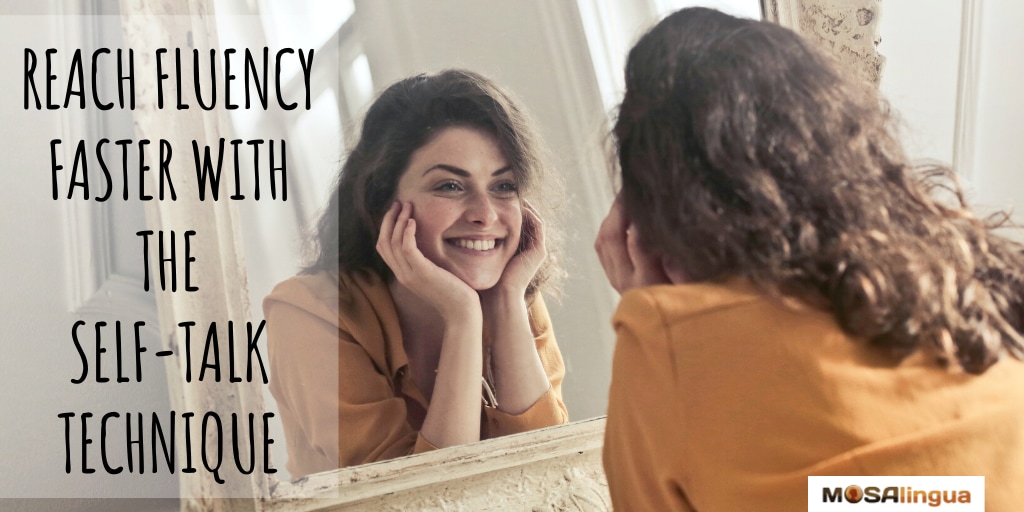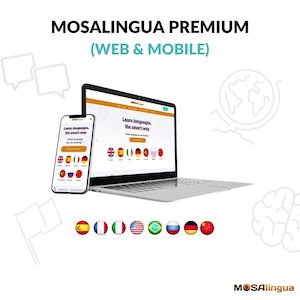In this article (and video), we’ll take a look at the fantastic self-talk technique. You can use it to get started speaking your target language out loud in a way that’s fun, comfortable and, most importantly, highly effective. Whether you’re taking your first steps to speaking out loud, or need more practice to reach a more advanced level, this simple but powerful hack is your new path to fluency.

If you’d prefer to listen to this article, head over to our MosaLingua Language Lab podcast:
Listen to “#37 – The Self-Talk Technique: a Shortcut to Fluency” on Spreaker.
Why People Have Difficulty Speaking Out Loud
If you’ve been putting off speaking your target language out loud because you don’t feel like you’re at a high enough level, or you’re nervous people won’t understand you or might even judge you, you’re definitely not alone. The spoken component of a language can be one of the most difficult parts to master. But it’s also the most rewarding and the most useful. Just think about all the reasons you decided to start learning a new language. I bet most of them involve speaking in some way. Travel? Work? Or maybe just to make new friends.
If you haven’t read our article and watched our YouTube video on this about overcoming the obstacles that hold learners back, be sure to check them out. But just for some context, we’ll quickly review some of the main reasons people have difficulty speaking out loud. Shyness and lack of confidence are probably the most common things that hold people back from speaking confidently. But other things come into play, too. Some people are too focused on perfecting the language before they start speaking. Others just can’t help but feel stressed out by speaking out loud. Finally, pessimism can also hold people back, by making learners feel like they’ll never get better no matter how much they practice. (Spoiler alert: nothing could be further from the truth.)
If you’ve experienced one or more of these obstacles, you’re not alone, but rest assured — the technique we’re about to teach you will help you overcome all of them. It’s called self-talk or self-conversation, and it’s a fantastic way to ease into speaking your new language out loud, in an environment that’s comfortable and fun.
Self-Talk: A Shortcut to Fluency
So, what is the self-talk technique? Well, it’s pretty much what it sounds like: you practice speaking your target language out loud… to yourself! Before you dismiss it as silly or nonsensical, though, we really encourage you to keep reading. This may just be the tool that gets you speaking your target language fluently, in less time than you ever thought possible.
The whole point is to speak to somebody you’re totally comfortable with, that you don’t have to worry about misunderstanding you. Imagine if you had a language partner that didn’t make you feel shy, and where mistakes didn’t matter. Where you didn’t feel stressed out, and where you can really learn the value of practicing in your own time.
Well, that partner exists — and it’s you! You can be your own most supportive speaking partner when you’re first starting out. While it may feel a little silly at first, we promise you: it’s a technique that all of us at MosaLingua have learned to love.
Self-talk also gives you lots of flexibility to practice your speaking. You can practice your target language almost anytime and anywhere.
How to get started
Hopefully by now, we’ve convinced you of just how useful this technique can be — and if not, try it anyway 😉 We’re confident that you’ll see its value after giving it a try.
In principle, it’s as easy as it sounds. To prepare yourself for speaking with new friends, colleagues, clients, whomever, practice different parts of a conversation by yourself. Introducing yourself, discussing hobbies and passions, describing a day in your life, or sharing one of your favorite funny stories. These are all great topics for self-conversation in the language you’re learning.
You can try playing both roles of the “dialogue.” Respond to your own statements and questions, as if you were talking to somebody else. It’s an unusual exercise… But a very useful one!
If you realize you’re missing a word, use your MosaLingua app or a good online dictionary to remind you or fill in a gap. You don’t have to worry about keeping anybody waiting, and you can take your time to find the word you need. No pressure or stress.
Take it a step further
The next important part of this technique is to record yourself whenever possible. This way, you can play back your self-talk dialogue, and identify and fix any mistakes you made in vocabulary, grammar, and especially pronunciation. Recording yourself also lets you go back and see how much progress you’ve made. This is a great way to overcome any pessimism or doubt you have about this exercise, or speaking in general.
Finally, it will help you get used to hearing your voice in your target language. Soon, it will feel a lot more natural and comfortable. This helps a lot when it comes to overcoming those feelings of shyness or and stress!
What About Conversations with Real People?
Can self-talk completely replace conversations with others? Definitely not. It’s a great way to get started, and many people find it more comfortable than speaking to a conversation partner in the beginning. But the goal here is to prepare yourself for having real conversations with other people. After all, that’s why you started learning your new language in the first place! Once you’ve had a little more practice with self-talk, you should start looking for conversation partners to keep improving.
How-To Video: The Self-Talk Technique
In the video below, Abbe explains how you can use the self-talk technique to improve your speaking skills in any language. Watch it on our YouTube channel or right here. The video is in English, but you can turn on subtitles in any of six languages. Feel free to slow down the playback as well. Click on the gear-icon in the lower right-hand corner of the video.
Remember to subscribe to our YouTube channel for tons more content about languages!
Related posts:
Want to start improving your language skills today?
Start learning a new language today

Good news: we can help!
More good news: you can get started for free! Start your free trial now and for the next 15 days, take advantage of the most effective language learning method on the market!
Vocabulary flashcards, videos with subtitles, audiobooks, articles adapted to your level – with MosaLingua Premium (Web & Mobile), you’ll have access to all this and more. Get started right now. It’s free—and risk-free—to try!




I have definitely found that self-talk helps me learn languages. When I was working at a restaurant in high school, I’d talk to myself at work and yell at myself in Japanese on the 40-min car drive home. Thanks for the post!